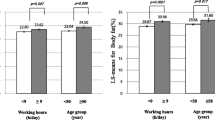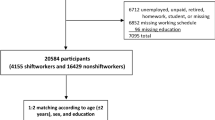Abstract
Purpose
Obesity is associated with many diseases and functional limitations. Workplaces are not always designed to accommodate this challenge. This study investigated the association between body mass index (BMI) and work ability in the general working population.
Methods
Currently employed wage earners (N = 10,427) from the 2010 round of the Danish Work Environment Cohort Study (DWECS) replied to questions about work and health. Cumulative logistic regression analyses controlling for age, gender, physical and psychosocial work factors, lifestyle, and chronic diseases modeled the associations between BMI and work ability.
Results
BMIs above the normal range were progressively associated with lower work ability in relation to the physical demands of the job. Odds ratios for having lower work ability were 1.11 (95% CI 1.01–1.22), 1.17 (95% CI 1.01–1.34), 1.43 (95% CI 1.09–1.88), 1.69 (95% CI 1.10–2.62) for overweight and obesity classes I, II, and III, respectively. In subgroup analyses, the associations between BMI and work ability were more pronounced among individuals with mainly sedentary work than among those with physically active work. BMI was not associated with work ability in relation to the mental demands of the work.
Conclusions
BMIs above the normal range are progressively associated with lower work ability in relation to the physical demands of the job, especially among individuals with mainly sedentary work. Ergonomic research on how to optimally design workstations for workers with obesity are needed.

Similar content being viewed by others
References
Alavinia SM, van den Berg TIJ, van Duivenbooden C et al (2009) Impact of work-related factors, lifestyle, and work ability on sickness absence among Dutch construction workers. Scand J Work Environ Health 35:325–333
Andersen LL, Garde AH (2015) Sleep problems and computer use during work and leisure: cross-sectional study among 7800 adults. Chronobiol Int 32:1367–1372. doi:10.3109/07420528.2015.1095202
Bach E, Andersen LL, Bjørner JB (2010) Arbejdsmiljø og helbred i Danmark 2010. http://www.arbejdsmiljoforskning.dk/da/nyheder/arkiv/2011/samlet-rapport-om-arbejdsmiljoe-og-helbred-i-danmark-2010. Accessed 20 Oct 2016
Boardley D, Pobocik RS (2009) Obesity on the rise. Prim Care Clin Off Pract 36:243–255. doi:10.1016/j.pop.2009.01.003
Calatayud J, Jakobsen MD, Sundstrup E et al (2015) Dose-response association between leisure time physical activity and work ability: cross-sectional study among 3000 workers. Scand J Public Health 43:819–824. doi:10.1177/1403494815600312
Committee System on Biomedical Research Ethics (2017) Committee System on Biomedical Research Ethics guidelines about notification. http://www.nvk.dk/~/media/NVK/Dokumenter/Vejledning_Engelsk.pdf. Accessed 27 June 2017
Després J-P (2012) Body fat distribution and risk of cardiovascular disease: an update. Circulation 126:1301–1313. doi:10.1161/CIRCULATIONAHA.111.067264
El Fassi M, Bocquet V, Majery N et al (2013) Work ability assessment in a worker population: comparison and determinants of Work Ability Index and Work Ability score. BMC Public Health 13:305. doi:10.1186/1471-2458-13-305
Finnish Institute of Occupational Health (2014) Background of the Work Ability Index. http://www.ttl.fi/en/health/wai/background/pages/default.aspx. Accessed 15 Aug 2016
Fischer FM, Martinez MC (2013) Individual features, working conditions and work injuries are associated with work ability among nursing professionals. Work Read Mass 45:509–517. doi:10.3233/WOR-131637
Gander JC, Sui X, Hébert JR et al (2015) Association of cardiorespiratory fitness with coronary heart disease in asymptomatic men. Mayo Clin Proc 90:1372–1379. doi:10.1016/j.mayocp.2015.07.017
Gharibi V, Mokarami H, Taban A et al (2016) Effects of work-related stress on Work Ability Index among Iranian workers. Saf Health Work 7:43–48. doi:10.1016/j.shaw.2015.10.005
Gunstad J, Lhotsky A, Wendell CR et al (2010) Longitudinal examination of obesity and cognitive function: results from the baltimore longitudinal study of aging. Neuroepidemiology 34:222–229. doi:10.1159/000297742
Hunter GR, Kekes-Szabo T, Snyder SW et al (1997) Fat distribution, physical activity, and cardiovascular risk factors. Med Sci Sports Exerc 29:362–369
Ilmarinen J (2007) The Work Ability Index (WAI). Occup Med 57:160. doi:10.1093/occmed/kqm008
Ilmarinen J (2009) Work ability—a comprehensive concept for occupational health research and prevention. Scand J Work Environ Health 35:1–5
Jakobsen MD, Sundstrup E, Brandt M et al (2015) Physical exercise at the workplace prevents deterioration of work ability among healthcare workers: cluster randomized controlled trial. BMC Public Health 15:1174. doi:10.1186/s12889-015-2448-0
James PT, Rigby N, Leach R, International Obesity Task Force (2004) The obesity epidemic, metabolic syndrome and future prevention strategies. Eur J Cardiovasc Prev Rehabil Off J Eur Soc Cardiol Work Groups Epidemiol Prev Card Rehabil Exerc Physiol 11:3–8
Kagawa M, Byrne NM, Hills AP (2008) Comparison of body fat estimation using waist:height ratio using different “waist” measurements in Australian adults. Br J Nutr 100:1135–1141. doi:10.1017/S0007114508966095
Kaplan RC, Avilés-Santa ML, Parrinello CM et al (2014) Body mass index, sex, and cardiovascular disease risk factors among Hispanic/Latino adults: hispanic community health study/study of Latinos. J Am Heart Assoc. doi:10.1161/JAHA.114.000923
Kaur J (2014) A comprehensive review on metabolic syndrome. Cardiol Res Pract 2014:943162. doi:10.1155/2014/943162
Laitinen J, Näyhä S, Kujala V (2005) Body mass index and weight change from adolescence into adulthood, waist-to-hip ratio and perceived work ability among young adults. Int J Obes 29:697–702. doi:10.1038/sj.ijo.0802936
Lemieux I, Lamarche B, Couillard C et al (2001) Total cholesterol/HDL cholesterol ratio vs LDL cholesterol/HDL cholesterol ratio as indices of ischemic heart disease risk in men: the Quebec Cardiovascular Study. Arch Intern Med 161:2685–2692
Li CY, Sung FC (1999) A review of the healthy worker effect in occupational epidemiology. Occup Med Oxf Engl 49:225–229
Nabe-Nielsen K, Garde AH, Clausen T, Jorgensen MB (2015) Does workplace health promotion reach shift workers? Scand J Work Environ Health 41:84–93. doi:10.5271/sjweh.3469
Niedhammer I, Bugel I, Bonenfant S et al (2000) Validity of self-reported weight and height in the French GAZEL cohort. Int J Obes Relat Metab Disord J Int Assoc Study Obes 24:1111–1118
Pejtersen JH, Kristensen TS, Borg V, Bjorner JB (2010) The second version of the Copenhagen Psychosocial Questionnaire. Scand J Public Health 38:8–24. doi:10.1177/1403494809349858
Pohjonen T (2001) Age-related physical fitness and the predictive values of fitness tests for work ability in home care work. J Occup Environ Med Am Coll Occup Environ Med 43:723–730
Poulsen K, Cleal B, Clausen T, Andersen LL (2014) Work, diabetes and obesity: a seven year follow-up study among Danish health care workers. PLoS One 9:e103425. doi:10.1371/journal.pone.0103425
Prickett C, Brennan L, Stolwyk R (2015) Examining the relationship between obesity and cognitive function: a systematic literature review. Obes Res Clin Pract 9:93–113. doi:10.1016/j.orcp.2014.05.001
Punnett L, Wegman DH (2004) Work-related musculoskeletal disorders: the epidemiologic evidence and the debate. J Electromyogr Kinesiol 14:13–23
Reeuwijk KG, Robroek SJW, Niessen MAJ et al (2015) The prognostic value of the Work Ability Index for sickness absence among office workers. PLoS One 10:e0126969. doi:10.1371/journal.pone.0126969
Sabia S, Kivimaki M, Shipley MJ et al (2009) Body mass index over the adult life course and cognition in late midlife: the Whitehall II Cohort Study. Am J Clin Nutr 89:601–607. doi:10.3945/ajcn.2008.26482
Schulte PA, Wagner GR, Ostry A et al (2007) Work, obesity, and occupational safety and health. Am J Public Health 97:428–436. doi:10.2105/AJPH.2006.086900
Selassie M, Sinha AC (2011) The epidemiology and aetiology of obesity: a global challenge. Best Pract Res Clin Anaesthesiol 25:1–9
Shrestha N, Pedisic Z, Neil-Sztramko S et al (2016) The impact of obesity in the workplace: a review of contributing factors, consequences and potential solutions. Curr Obes Rep 5:344–360. doi:10.1007/s13679-016-0227-6
Sundstrup E, Jakobsen MD, Brandt M et al (2014) Workplace strength training prevents deterioration of work ability among workers with chronic pain and work disability: a randomized controlled trial. Scand J Work Environ Health 40:244–251. doi:10.5271/sjweh.3419
Sundstrup E, Jakobsen MD, Mortensen OS, Andersen LL (2017) Joint association of multimorbidity and work ability with risk of long-term sickness absence: a prospective cohort study with register follow-up. Scand J Work Environ Health 43:146–154. doi:10.5271/sjweh.3620
The Danish Data Protection Agency (2017) The Danish Data Protection Agency standard terms for research projects. https://www.datatilsynet.dk/erhverv/forskere-og-medicinalfirmaer/standard-terms-for-research-projects/. Accessed 11 Aug 2016
Thorp AA, Kingwell BA, Owen N, Dunstan DW (2014) Breaking up workplace sitting time with intermittent standing bouts improves fatigue and musculoskeletal discomfort in overweight/obese office workers. Occup Environ Med 71:765–771. doi:10.1136/oemed-2014-102348
Tuomi K, Eskelinen L, Toikkanen J et al (1991) Work load and individual factors affecting work ability among aging municipal employees. Scand J Work Environ Health 17(Suppl 1):128–134
Tuomi K, Huuhtanen P, Nykyri E, Ilmarinen J (2001) Promotion of work ability, the quality of work and retirement. Occup Med Oxf Engl 51:318–324
van den Berg TIJ, Elders LAM, de Zwart BCH, Burdorf A (2009) The effects of work-related and individual factors on the Work Ability Index: a systematic review. Occup Environ Med 66:211–220. doi:10.1136/oem.2008.039883
von Eyben FE, Mouritsen E, Holm J et al (2003) Intra-abdominal obesity and metabolic risk factors: a study of young adults. Int J Obes Relat Metab Disord J Int Assoc Study Obes 27:941–949. doi:10.1038/sj.ijo.0802309
Wang C, Chan JSY, Ren L, Yan JH (2016) Obesity reduces cognitive and motor functions across the lifespan. Neural Plast 2016:2473081. doi:10.1155/2016/2473081
Williams MJ, Hunter GR, Kekes-Szabo T et al (1997) Regional fat distribution in women and risk of cardiovascular disease. Am J Clin Nutr 65:855–860
World Health Organization (2016) Global database on body mass index. http://apps.who.int/bmi/index.jsp?introPage=intro_3.html. Accessed 11 Aug 2016
Acknowledgements
The authors are grateful to colleagues Elsa Bach and Ebbe Villadsen at NRCWE for valuable discussions and assistance with access to data from the Danish Work Environment Cohort Study.
Author information
Authors and Affiliations
Corresponding author
Ethics declarations
Conflict of interest
The authors declare that there is no conflict of interest regarding the publication of this paper.
Funding
The Danish Work Environment Cohort Study (DWECS) was funded by the Danish Government as part of the surveillance of the Danish working environment. No external funding was obtained for the specific analyses or writing of the present article. No commercial associations, current and over the past 5 years, that might pose a conflict of interest.
Rights and permissions
About this article
Cite this article
Andersen, L.L., Izquierdo, M. & Sundstrup, E. Overweight and obesity are progressively associated with lower work ability in the general working population: cross-sectional study among 10,000 adults. Int Arch Occup Environ Health 90, 779–787 (2017). https://doi.org/10.1007/s00420-017-1240-0
Received:
Accepted:
Published:
Issue Date:
DOI: https://doi.org/10.1007/s00420-017-1240-0




